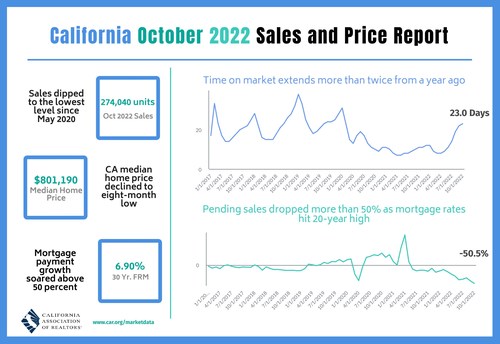California’s housing market continued shifting in October as the monthly average 30-year fixed rate mortgage hovered near 7 percent and led to the lowest sales level since February 2008 and the largest year-over-year decline since December 2007, outside of the pandemic, the CALIFORNIA ASSOCIATION OF REALTORS® (C.A.R.) said today.

Closed escrow sales of existing, single-family detached homes in California totaled a seasonally adjusted annualized rate of 274,040 in October, according to information collected by C.A.R. from more than 90 local REALTOR® associations and MLSs statewide. The statewide annualized sales figure represents what would be the total number of homes sold during 2022 if sales maintained the October pace throughout the year. It is adjusted to account for seasonal factors that typically influence home sales. October’s sales pace was down 10.4 percent on a monthly basis from 305,680 in September and down 36.9 percent from a year ago, when 434,170 homes were sold on an annualized basis.
Home sales have been on a downward trend for 16 straight months on a year-over-year basis. It was the third time in the last four months that sales dropped more than 30 percent from the year-ago level. The monthly 10.4 percent sales decline was worse than the long-run average of +0.5 percent change recorded between a September and an October in the past 43 years. Sales in all price segments continued to drop by 30 percent or more year-over-year, with the $750,000–$999,000 price segment falling the most at 40.8 percent. The high-end market ($1 million–$1,999,000) experienced the smallest sales drop at 34.1 percent.
“While October’s sales and price results were weaker than what we’ve experienced in the past couple of years and could slow further in the upcoming off-season, the market bottom could be in sight,” said 2023 C.A.R. President Jennifer Branchini, a Bay Area REALTOR®. “Homes are still selling relatively quickly at 23 days on the market, one in four homes is selling above list price due to limited inventory, and with median price growth remaining positive in four of the five price segments, home prices are holding up reasonably well.”
California’s median home price declined 2.5 percent in October to $801,190 from the $821,680 recorded in September. The October price was 0.3 percent higher than the $798,440 recorded last October and was the smallest year-over-year price gain in 29 months. October marked the fifth consecutive month with a single-digit annual price increase. With the average 30-year fixed mortgage rate expected to remain above 6.5 percent for the rest of the year, home prices will moderate further in the coming months as affordability remains a challenge.
“Excluding the three-month pandemic lockdown period in spring 2020, October’s sales level was the lowest since February 2008. With pending sales showing a 50 percent drop from a year ago, we can expect additional tempering in housing demand in the coming months, as we previously forecasted,” said C.A.R. Vice President and Chief Economist Jordan Levine. “Home prices will also moderate further over the next several months as interest rates remain elevated in the near term and seasonal factors come into play.”
Other key points from C.A.R.’s October 2022 resale housing report include:
Note: The County MLS median price and sales data in the tables are generated from a survey of more than 90 associations of REALTORS® throughout the state and represent statistics of existing single-family detached homes only. County sales data is not adjusted to account for seasonal factors that can influence home sales. Movements in sales prices should not be interpreted as changes in the cost of a standard home. The median price is where half sold for more and half sold for less; medians are more typical than average prices, which are skewed by a relatively small share of transactions at either the lower end or the upper end. Median prices can be influenced by changes in cost, as well as changes in the characteristics and the size of homes sold. The change in median prices should not be construed as actual price changes in specific homes.
*Sales-to-list-price ratio is an indicator that reflects the negotiation power of home buyers and home sellers under current market conditions. The ratio is calculated by dividing the final sales price of a property by its last list price and is expressed as a percentage. A sales-to-list ratio with 100 percent or above suggests that the property sold for more than the list price, and a ratio below 100 percent indicates that the price sold below the asking price.
**Price per square foot is a measure commonly used by real estate agents and brokers to determine how much a square foot of space a buyer will pay for a property. It is calculated as the sale price of the home divided by the number of finished square feet. C.A.R. currently tracks price-per-square foot statistics for 50 counties.
Leading the way…® in California real estate for more than 110 years, the CALIFORNIA ASSOCIATION OF REALTORS® (www.car.org) is one of the largest state trade organizations in the United States with more than 217,000 members dedicated to the advancement of professionalism in real estate. C.A.R. is headquartered in Los Angeles.